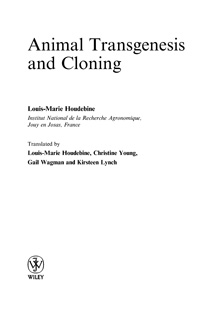Animal Transgenesis and Cloning
| Автор(ы): | Houdebine Louis-Marie
06.10.2007
|
| Год изд.: | 2003 |
| Описание: | Since the beginning of time, humans have known how to distinguish living organisms from inanimate objects. Cro-Magnon people and their descendants were no doubt aware that living beings all had the same ability to grow and multiply by respecting the specificity of the species. It probably took them longer to understand that heat destroyed living organisms, whereas the cold, to a certain extent, conserved them. These very ancient observations have fixed in our minds the notion that living organisms are fundamentally different from inanimate matter. We now know that living beings are also subject to the laws of thermodynamics, that they are no more than very highly organized matter and that they only conserve their wholeness below about 130 °C. This book on transgenesis and cloning. Everything you wanted to know but were afraid to ask. |
| Оглавление: |
 Обложка книги.
Обложка книги.
Abbreviations and Acronyms [13] 1 From the gene to the transgenic animal [1] 1.1 Genome composition [1] 1.2 Gene structure [4] 1.3 The number of genes in genomes [7] 1.4 The major techniques of genetic engineering [13] 1.4.1 Gene cloning [13] 1.4.2 DNA sequencing [14] 1.4.3 In vitro gene amplification [14] 1.4.4 Gene construction [14] 1.4.5 Gene transfer into cells [16] 1.5 The systematic description of genomes [21] 1.6 Classical genetic selection [26] 1.7 Experimental mutation in genomes [27] 1.7.1 Chemical mutagenesis [27] 1.7.2 Mutagenesis by integration of foreign DNA [29] 1.7.3 Mutagenesis by transgenesis [30] 2 Techniques for cloning and transgenesis [33] 2.1 Cloning [33] 2.1.1 The main steps of differentiation [33] 2.1.2 Cloning by nuclear transfer [37] 2.2 Gene therapy [48] 2.2.1 The goals of gene therapy [48] 2.2.2 The tools of gene therapy [49] 2.2.3 The applications of gene therapy [52] 2.3 Techniques of animal transgenesis [54] 2.3.1 The aims and the concept of animal transgenesis [54] 2.3.2 Gene transfer into gametes [60] 2.3.3 Gene transfer into embryos [65] 2.3.4 Gene transfer via cells [69] 2.3.5 Vectors for gene addition [73] 2.3.6 Vectors for gene replacement [85] 2.3.7 Vectors for the rearrangement of targeted genes [90] 2.3.8 Targeted integration of foreign genes [97] 2.3.9 Non-classical vectors for the recombination of targeted genes [105] 2.3.10 Vectors for gene trap [106] 2.3.11 Vectors for the expression of transgenes [116] 3 AppKcations of cloning and transgenesis [137] 3.1 Applications of animal cloning [137] 3.1.1 Basic research [137] 3.1.2 Transgenesis [142] 3.1.3 Animal reproduction [143] 3.1.4 Human reproduction [144] 3.1.5 Therapeutic cloning [144] 3.1.6 Xenografting [150] 3.2 Applications of animal transgenesis [153] 3.2.1 Basic research [153] 3.2.2 Study of human diseases [154] 3.2.3 Pharmaceutical production [159] 3.2.4 Xenografting [162] 3.2.5 Breeding [163] 4 Limits and risks of cloning, gene therapy and transgenesis [171] 4.1 Limits and risks of cloning [173] 4.1.1 Reproductive cloning in humans [173] 4.1.2 Reproductive cloning in animals [175] 4.1.3 Therapeutic cloning [176] 4.2 Limits and risks of gene therapy [177] 4.3 Limits and risks of transgenesis [178] 4.3.1 Technical and theoretical limits [178] 4.3.2 Biosafety problems in confined areas [179] 4.3.3 The intentional dissemination of transgenic animals into the environment [181] 4.3.4 The risks for human consumers [184] 4.3.5 Transgenesis and animal welfare [185] 4.3.6 Patenting of transgenic animals [187] 4.3.7 Transgenesis in humans [188] Conclusion and Perspectives [191] References [199] Index [217] |
| Формат: | djvu |
| Размер: | 1810032 байт |
| Язык: | ENG |
| Рейтинг: |
383
|
| Открыть: | Ссылка (RU) |